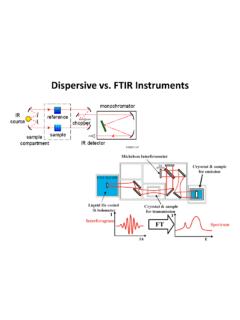Transcription of Chapter 1 Structure and Bonding - Michigan State University
1 John E. McMurry Paul D. Adams University of Arkansas Chapter 1 Structure and Bonding Organic chemistry is study of carbon compounds. Why is it so special? 90% of more than 30 million chemical compounds contain carbon. Examination of carbon in periodic chart answers some of these questions. Carbon is group 4A element, it can share 4 valence electrons and form 4 covalent bonds. Origins of Organic Chemistry Review ideas from general chemistry: atoms, bonds, molecular geometry Why This Chapter ? Structure of an atom: small diameter (2 10-10 m = 200 pm) Nucleus very dense protons (positively charged) neutrons (neutral) small (10-15 m) Electrons negatively charged located in space remindful of a cloud (10-10 m) around nucleus Atomic Structure [ ngstr m ( ) is 10-10 m = 100 pm] The atomic number (Z): number of protons in nucleus The mass number (A): number of protons plus neutrons All atoms of same element have the same Z value Isotopes: atoms of the same element with different numbers of neutrons and thus different A The atomic mass (atomic weight) of an element is weighted average mass in atomic mass units (amu) of an element s naturally occurring isotopes.
2 Carbon: Atomic Number and Atomic Mass 12C6 ACZ13C6( ) ( ) + = Four different kinds of orbitals for electrons based on those derived for a hydrogen atom Denoted s, p, d, and f s and p orbitals most important in organic and biological chemistry s orbitals: spherical, nucleus at center p orbitals: dumbbell-shaped, nucleus at middle d orbitals: elongated dumbbell-shaped, nucleus at center Shapes of Atomic Orbitals for Electrons Orbitals are grouped in shells of increasing size and energy Different shells contain different numbers and kinds of orbitals Each orbital can be occupied by two electrons Orbitals and Shells (Continued) First shell contains one s orbital, denoted 1s, holds only two electrons Second shell contains one s orbital (2s) and three p orbitals (2p), eight electrons Third shell contains an s orbital (3s), three p orbitals (3p), and five d orbitals (3d), 18 electrons Orbitals and Shells (Continued) In each shell there are three perpendicular p orbitals, px, py, and pz, of equal energy Lobes of a p orbital are separated by region of zero electron density, a node P-Orbitals ground - State electron configuration ( , lowest energy arrangement) of atom lists orbitals occupied by its electrons.
3 Rules: 1. Lowest-energy orbitals fill first: 1s 2s 2p 3s 3p 4s 3d (Aufbau ( build-up ) principle) Atomic Structure : electron Configurations ground - State electron configuration ( , lowest energy arrangement) of atom lists orbitals occupied by its electrons. Rules: 2. Electrons act as if they were spinning around an axis. electron spin can have only two orientations, up and down . Only two electrons can occupy an orbital, and they must be of opposite spin (Pauli exclusion principle) to have unique wave equations Atomic Structure : electron Configurations ground - State electron configuration ( , lowest energy arrangement) of atom lists orbitals occupied by its electrons. Rules: 3. If two or more empty orbitals of equal energy are available, electrons occupy each with spins parallel until all orbitals have one electron (Hund's rule). To the chalkboard (p-orbital filling as example) Atomic Structure : electron Configurations Atoms form bonds because the resulting compound is more stable than the separate atoms Ionic bonds in salts form by electron transfers Organic compounds have covalent bonds from sharing electrons (G.)
4 N. Lewis, 1916) Development of Chemical Bonding Theory Lewis structures ( electron dot) show valence electrons of an atom as dots Hydrogen has one dot, representing its 1s electron Carbon has four dots (2s2 2p2) due to 4 e- in valence shell Kekul structures (line-bond structures) have a line drawn between two atoms indicating a 2 e- covalent bond. Stable molecule results at completed shell, octet (eight dots) for main-group atoms (two for hydrogen) Development of Chemical Bonding Theory Atoms with one, two, or three valence electrons form one, two, or three bonds. Development of Chemical Bonding Theory valence e- valence e- Atoms with four or more valence electrons form as many bonds as electrons needed to fill the s and p levels of their valence shells to reach a stable octet. Carbon has four valence electrons (2s2 2p2), forming four bonds (CH4). Development of Chemical Bonding Theory valence e- Nitrogen has five valence electrons (2s2 2p3) but forms only three bonds (NH3).
5 Development of Chemical Bonding Theory valence e- Oxygen has six valence electrons (2s2 2p4) but forms two bonds (H2O) Development of Chemical Bonding Theory valence e- Development of Chemical Bonding Theory Valence electrons not used in Bonding are called nonbonding electrons, or lone-pair electrons Nitrogen atom in ammonia (NH3) Shares six valence electrons in three covalent bonds and remaining two valence electrons are nonbonding lone pair Non- Bonding Electrons Covalent bond forms when two atoms approach each other closely so that a singly occupied orbital on one atom overlaps a singly occupied orbital on the other atom Two models to describe covalent Bonding . Valence bond theory Molecular orbital theory Describing Chemical Bonds: Valence Bond Theory Valence Bond Theory: Electrons are paired in the overlapping orbitals and are attracted to nuclei of both atoms H H bond results from the overlap of two singly occupied hydrogen 1s orbitals H-H bond is cylindrically symmetrical, sigma ( ) bond Describing Chemical Bonds: Valence Bond Theory cylindrically symmetrical Reaction 2 H H2 releases 436 kJ/mol , product has 436 kJ/mol less energy than two atoms.
6 H H has bond strength of 436 kJ/mol Bond Energy Distance between nuclei that leads to maximum stability If too close, they repel because both are positively charged If too far apart, Bonding is weak Bond Energy Kekul and Couper independently observed that carbon always has four bonds van't Hoff and Le Bel proposed that the four bonds of carbon have specific spatial directions Atoms surround carbon as corners of a tetrahedron Describing Chemical Bonding Theory Carbon has 4 valence electrons (2s2 2p2) In CH4, all C H bonds are identical (tetrahedral) sp3 hybrid orbitals: an s orbital and three p orbitals combine: form four equivalent, unsymmetrical, tetrahedral orbitals (s + ppp = sp3) sp3 Orbitals and the Structure of Methane Linus Pauling (1931): his picture near men s bathroom across from elevators sp3 orbitals on C overlap with 1s orbitals on 4 H atoms to form four identical C-H bonds Each C H bond has a strength of 439 kJ/mol and length of 109 pm Bond angle: each H C H is : the tetrahedral angle.
7 The Structure of Methane sp3 Orbital-based Structure of Hexane Some Representations of Ethylene are given To explain planar geometry and trigonal shape about C s in ethylene sp2 Orbitals and the Structure of Ethylene CCHHHHH2 CCH2 CCHHHH sp2 hybrid orbitals: 2s orbital combines with two 2p orbitals, giving 3 orbitals (s + pp = sp2). This results in a double bond. sp2 orbitals are in a plane with120 angles Remaining p orbital is perpendicular to the plane sp2 Orbitals and the Structure of Ethylene Two sp2-hybridized orbitals overlap to form a bond p orbitals overlap side-to-side to formation a pi ( ) bond sp2 sp2 bond and 2p 2p bond result in sharing four electrons and formation of C-C double bond Bonds From sp2 Hybrid Orbitals Electrons in the bond are centered between nuclei Electrons in the bond occupy regions are on either side of a line between nuclei Bonds From sp2 Hybrid Orbitals H atoms form bonds with four sp2 orbitals H C H and H C C bond angles of about 120 C C double bond in ethylene shorter and stronger than single bond in ethane Ethylene C=C bond length 134 pm (C C 154 pm)
8 Structure of Ethylene Sharing of six electrons forms C C Two sp orbitals form bonds with hydrogens sp Orbitals and the Structure of Acetylene C-C a triple bond sharing six electrons Carbon 2s orbital hybridizes with a single p orbital giving two sp hybrids two p orbitals remain unchanged sp orbitals are linear, 180 apart on x-axis Two p orbitals are perpendicular on the y- axis and the z- axis sp Orbitals and the Structure of Acetylene Two sp hybrid orbitals from each C form sp sp bond pz orbitals from each C form a pz pz bond by sideways overlap and py orbitals overlap similarly Orbitals of Acetylene Elements other than C can have hybridized orbitals H N H bond angle in ammonia (NH3) C-N-H bond angle is N s orbitals (sppp) hybridize to form four sp3 orbitals One sp3 orbital is occupied by two nonbonding electrons, and three sp3 orbitals have one electron each, forming bonds to H and CH3. Hybridization of Nitrogen and Oxygen Hybridization of Sulfur A molecular orbital (MO): where electrons are most likely to be found (specific energy and general shape) in a molecule Additive combination ( Bonding ) MO is lower in energy Subtractive combination (antibonding) MO is higher energy Describing Chemical Bonds: Molecular Orbital Theory The Bonding MO is from combining p orbital lobes with the same algebraic sign The antibonding MO is from combining lobes with opposite signs Only Bonding MO is occupied Molecular Orbitals in Ethylene Drawing every bond in organic molecule can become tedious.
9 Several shorthand methods have been developed to write structures. Condensed structures don t have C-H or C-C single bonds shown. They are understood. Drawing Structures (Avoided in this Class) General Rules: 1) Carbon atoms aren t usually shown Drawing Skeletal Structures (Commonly Used) General Rules: 2) Instead a carbon atom is assumed to be at each intersection of two lines (bonds) and at the end of each line. Drawing Skeletal Structures (Commonly Used) General Rules: 3) Hydrogen atoms bonded to carbon aren t shown. Drawing Skeletal Structures (Commonly Used) General Rules: 4) Atoms other than carbon and hydrogen ARE shown Drawing Skeletal Structures (Commonly Used) Organic chemistry chemistry of carbon compounds Atom: charged nucleus containing positively charged protons and netrually charged neutrons surrounded by negatively charged electrons Electronic Structure of an atom described by wave equation Electrons occupy orbitals around the nucleus.
10 Different orbitals have different energy levels and different shapes s orbitals are spherical, p orbitals are dumbbell-shaped Covalent bonds - electron pair is shared between atoms Valence bond theory - electron sharing occurs by overlap of two atomic orbitals Molecular orbital (MO) theory - bonds result from combination of atomic orbitals to give molecular orbitals, which belong to the entire molecule Summary Sigma ( ) bonds - Circular cross-section and are formed by head-on interaction Pi ( ) bonds - dumbbell shape from sideways interaction of p orbitals Carbon uses hybrid orbitals to form bonds in organic molecules. In single bonds with tetrahedral geometry, carbon has four sp3 hybrid orbitals In double bonds with planar geometry, carbon uses three equivalent sp2 hybrid orbitals and one unhybridized p orbital Carbon uses two equivalent sp hybrid orbitals to form a triple bond with linear geometry, with two unhybridized p orbitals Atoms such as nitrogen and oxygen hybridize to form strong, oriented bonds The nitrogen atom in ammonia and the oxygen atom in water are sp3-hybridized Summary (Continued) Draw an electron -dot Structure for acetonitrile, C2H3N, which contains a carbon-nitrogen triple bond.









